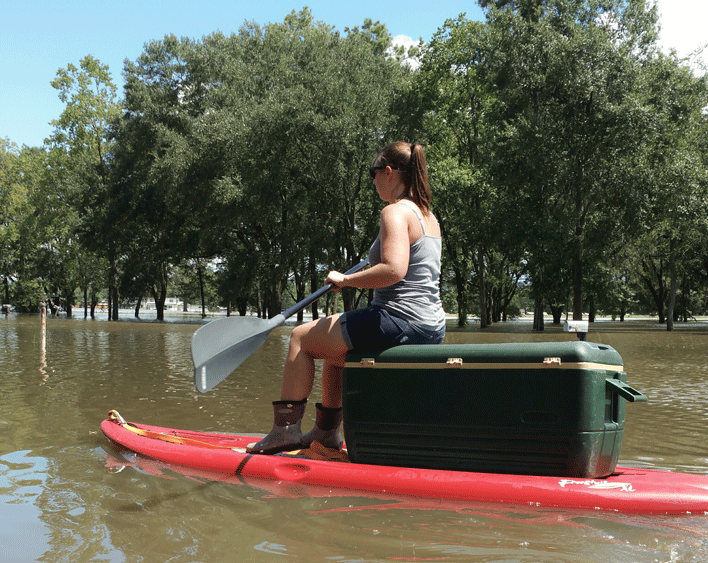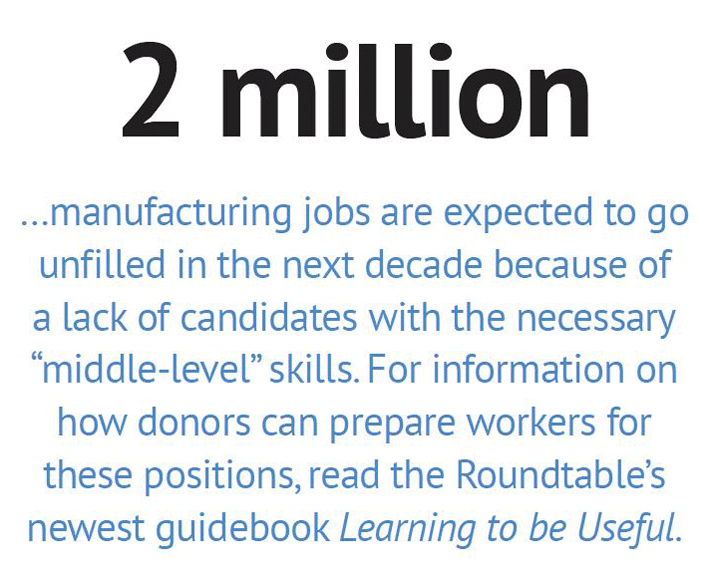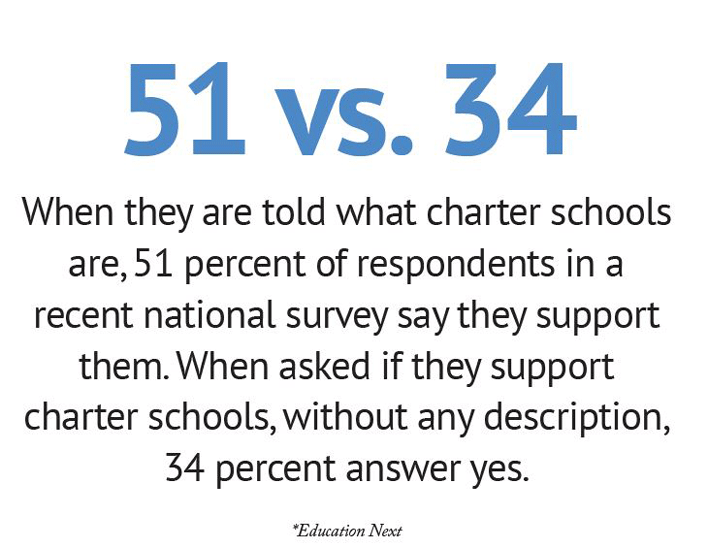Little Platoons on Pontoons
In August, a no-name tropical storm flooded more than 60,000 homes in Louisiana and turned half the state into an emergency zone. The Red Cross deemed it “the worst natural disaster to strike the U.S. since Superstorm Sandy,” but it received only a fraction of the national attention and support.

An intrepid “Cajun Pocahontas” paddles diapers and sandwiches to a young family stranded by the Louisiana flood. (Joshua Bihm)
Louisianans did not wait for help to come to them, but dove right in to assist their neighbors. A volunteer flotilla dubbed the Cajun Navy puttered around rescuing people and delivering supplies. Residents whose homes were still intact hosted people overflowing from crowded shelters as guests. Hospital employees traveled through floodwaters to keep services available. One Good Samaritan delivered tequila drinks in the rain.
Schoolteacher Thomas Achord summed it up this way: “Louisiana is most beautiful when it is a great disaster. The entire society spontaneously comes together as if joined by familial ties. No one watches his neighbor suffer but all selflessly and voluntarily go about seeking whom they can help. And they do so with their own personal means—trucks, boats, rafts, chainsaws, shovels, food, and often at risk of their lives. We work hard and we eat grand, we are filthy but laughing, we lose our homes yet are welcomed into others. I have seen finer lands but not people. Keep the world and give me Louisiana, even in disaster.”
Crisp Progress in the Big Apple
The latest test scores out of New York City indicate that a Hail Mary to save some high-risk Catholic schools just may have worked. Catholic schools governed by the Partnership for Inner-City Education network revealed that reading and math learning gains outpaced those of public schools across the city and state, including charter schools.
Third through eighth graders in Partnership-run schools displayed a 16-point year-to-year increase on English assessments, and a 13-point gain in math. There is still work to do, as fewer than half of students are proficient in math and reading, but the last couple years’ progress has been almost miraculous.
The Partnership is the result of an unusual agreement that shifted operation of six struggling schools from the Catholic Archdiocese of New York to a donor-backed charity. The Partnership’s philanthropists and staffers assumed management of everything from hiring and firing, to curriculum development, to payroll. The schools maintain their Catholic identity. One of the Partnership schools, Our Lady Queen of Angels, hosted Pope Francis in 2015 during his first-ever visit to an American parochial school.
Had the Partnership and its supporters not intervened, the doors to these schools would have been permanently closed several years ago, leaving thousands of students displaced in low-income neighborhoods in the Bronx and Harlem. Instead, they are sparkling with new promise. —Pat Burke

(The Manufacturing Institute and Deloitte consulting)
Private Funding Fuels African-American Museum
The new National Museum of African American History and Culture opened in September, thanks largely to unprecedented participation from individual donors.
The Smithsonian Institute raised $265 million from private contributors in order to build the $500 million museum. Major donors included the Lilly Endowment, Atlantic Philanthropies, Robert Smith, Oprah Winfrey, David Rubenstein, Colin Powell, and the Gates, Ford, Rockefeller, and Mellon Foundations. African Americans represent 74 percent of the individuals who gave $1 million or more.

Introducing a new Smithsonian, with the largest donor base of them all. (roma g)
Individuals donated many family artifacts to the museum’s Save Our African American Treasures program. Shirley Burke donated her enslaved great-grandfather’s violin. T. B. Boyd III offered the printing press his grandfather used to support himself after slavery. Robert Hicks donated a white shirt he wore when he became the first black supervisor at a factory in his town.
Director Lonnie Bunch believed “it was important to show average people owned this project,” so the museum also conducted grassroots fundraising. Months before the museum even opened, more than 100,000 people had already pledged $25 a year to become members. This is the largest member base out of all the Smithsonians. —Jen Para
Nonprofits Brace for New Overtime Rules
New regulations from the U.S. Department of Labor promise to upend the balance sheets of many nonprofits. Their new rules say that full-time employees earning a salary of $47,476 or below—more than double the current threshold—must now be paid overtime any week they put in more than 40 hours.
Experts say that could wreak havoc with nonprofit budgets. Many organizations run on thin operating margins, can’t raise prices on the services they offer, and do cyclical work that employees know will be heavy one week and light the next.
Charities tried to warn federal bureaucrats, expressing concerns when the Administration proposed to change the Fair Labor Standards Act (a New Deal remnant). YMCAs said they would have to cut staff or the hours staff could work. The Boy Scouts of America said the consequences would be “devastating.” MHY Family Services, which helps troubled youth, told a House committee that the new rules could result in nearly $800,000 added to its annual expenses, a 9 percent increase in its budget. Some groups like Catholic Charities, Easter Seals, and the YWCA, however, stated that “the justice we seek for our clients in the world must also exist within our own organizations.”
With the new rules slated to go into effect December 1, nonprofits are scrambling to figure out how to comply. “We don’t want the federal law to change our level of compassion and caring,” says David Thompson, a former labor lawyer who now works at the National Council of Nonprofits. The major options for charitable groups will be to put careful caps on employees’ work hours or move them to hourly wages instead of salaries.
Nancy Duncan of Operation Smile isn’t sure which tactic her organization will use. While the rule was being considered, Duncan told federal legislators that Operation Smile would incur an additional $1 million in payroll costs and be forced to do 4,200 fewer surgeries on poor children with cleft lips or other facial deformities. Her biggest challenge is figuring out how to pay about 30 program coordinators who currently earn between $33,000 and $35,000 on average. Based in the U.S., program coordinators oversee Operation Smile’s work in a particular country and often put in far more than 40 hours per week when they visit that country for trips to meet with local donors or hospitals.

New regulations are making Operation Smile frown. (Operation Smile)
While the new rules may boost some salaries, it will mean less of the flexibility that workers value in many nonprofit jobs. Many charities are finding out that the compensatory time they currently offer to employees is illegal under federal law.
There will also be increased administrative work, since the rules have nuances related to job duties and other matters. Payroll may become more cumbersome where more employees are paid hourly or need overtime bonuses. Even the Department of Labor itself has trouble following the rules: It recently agreed to fork over $7 million after it failed to pay overtime wages to thousands of employees.
“At the end of the day you are increasing costs, so you have to figure out how make up for it,” says AEI economist Aparna Mathur. —Liz Essley Whyte
A Screwtape for Millennials
A critic, a playwright, a choreographer, and an Olympic gymnast have teamed up with donors to bring a new C. S. Lewis-inspired show to the stage. It’s a satire called The Loser Letters that follows the spiritual travails of a young woman. According to Jeff Fiske, who wrote the script, she is “dealing with a lot of things that women in their twenties deal with,” from a lousy boyfriend to large questions of life purpose and God’s existence.
The play is adapted from a novel by Catholic writer Mary Eberstadt, author of several books, most recently How the West Really Lost God. As its young protagonist journeys away from faith, she writes letters to famous atheists like Richard Dawkins and the late Christopher Hitchens, offering pithy advice in the hope of helping them win over more Christians. The clever dialogue ends up being a defense for God’s existence.
Catholic intellectual Michael Novak suggested to Eberstadt after she published The Loser Letters in 2010 that it should become a stage play. And he wrote her the first check to help make that happen. The John Templeton Foundation and philanthropists Bill Simon and Gay Gaines offered support, and a theatrical production was created. Olympic silver-medal gymnast Chelssie Memmel starred as Shadow, the inner demon of the protagonist, in the premiere at Catholic University of America.

(Education Next)
Education Reform at an Ideological Crossroads
Robert Pondiscio and Checker Finn of the Fordham Institute have recently commented on the ideological rift now being seen within the school reform movement—which is marginalizing participants who bring anything other than textbook “progressive” credentials to their work. Education conferences, think tank discussions, funder gatherings, and media stories increasingly focus on racial topics, economic issues, ethnicity, political goals, and ideological priorities. The NAACP recently called for a moratorium on charter schools at its annual convention. The broad coalition that has pushed for better urban schools, which often brought together strange bedfellows, is now showing signs of splintering over litmus tests on issues other than education policy.
Pondiscio, Finn, and others warn that ostracization is starting to replace collaboration, and that the leftward shift of education reformers threatens bipartisan coalitions in scores of state legislatures that have produced valuable advances like improved teacher training and assessment, school choice, and personalized learning. Tying the education reform movement to contentious side issues like immigration, policing, and causes of poverty can only slow progress on classroom priorities. Donors need to be aware that politicization is threatening the coalitions that have created excellent schooling in underserved neighborhoods—and use their grantmaking influence to preserve the broad community alliances that have avoided ideological battles over the last generation in order to put kids first. —Pat Burke
In Memoriam: Terry Kohler
“When do we leave?” was the common refrain of philanthropist Terry Kohler, who passed away in late September at the age of 82. Known for his love of the outdoors, particularly sailing and birds, he and his wife, Mary, were often up for special missions, specifically ones linked to aviation and conservation. When Wisconsin governor Tommy Thompson asked Kohler to fly to Alaska to transport precious trumpeter-swan eggs to the Milwaukee Zoo, there was no hesitation, and his penchant for adventure resulted in more than 5,000 trumpeter swans, with their eight-foot wingspan, now gracing the Midwest. Ever-ready to take to the skies, he also helped save the whooping crane by leading flocks to a new habitat in an ultralight airplane, and helped excavate rare dinosaur fossils with his copter.
A native of Sheboygan, Wisconsin, Kohler was the great-grandson of the founder of the plumbing company by the same name. Both his father and grandfather were governors of the Badger State, and Kohler himself ran for office in 1982. While he lost the election, he married his campaign manager, Mary, and together they embarked on a philanthropic journey rooted in curiosity, patriotism, and elbow grease, taking on volunteer roles to supplement their checks. Informed by Terry’s experience leading the Vollrath Company from $13 million in annual sales to $300 million, the couple supported efforts to bolster the free enterprise system that buoyed them and their employees. Other beneficiaries of their generosity include the International Crane Foundation, Ducks Unlimited, and conservative policy thought leaders like the Institute for World Politics and the St. Croix Review.
The Kohlers also focused on strengthening marriage, supporting Great Marriages Sheboygan and The Philanthropy Roundtable’s Culture of Freedom project. Having gone through a divorce before his marriage to Mary, Kohler told Philanthropy that “intact families are most successful for the upbringing of children…. I’m not trying to imply that everybody who is getting or has gotten a divorce is bad. I’ve failed in that department myself. But we ought to make it as easy and desirable as possible for people to maintain intact families.”
To learn more about Mary and Terry Kohler’s philanthropy, read the Summer 2014 issue, with an exclusive interview and additional information about Terry and Mary’s trek across Russia to save the Siberian crane. Their conservation work is also documented in The Almanac of American Philanthropy in the Great Achievements in Nature compendium.
